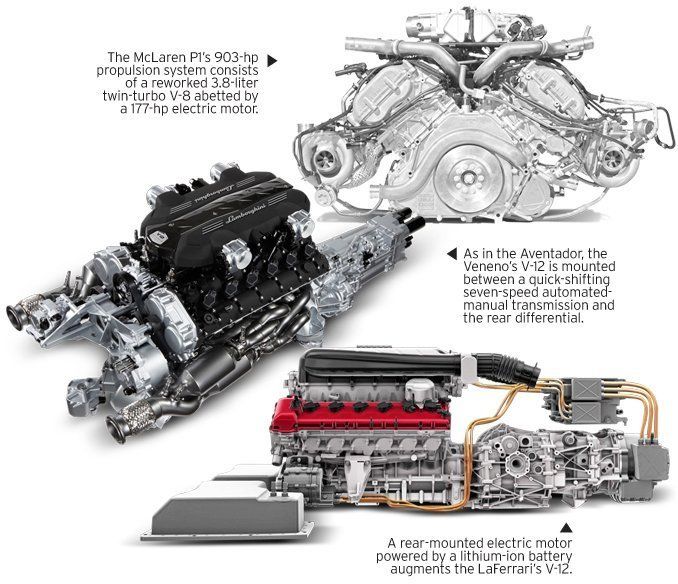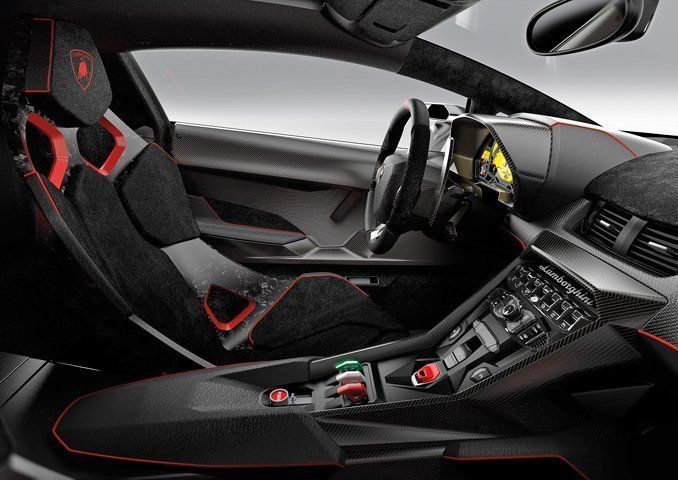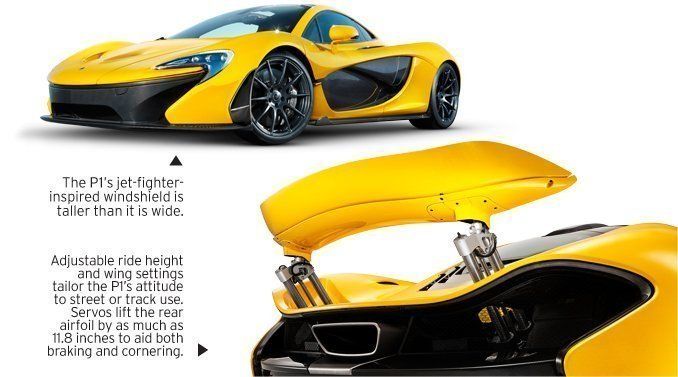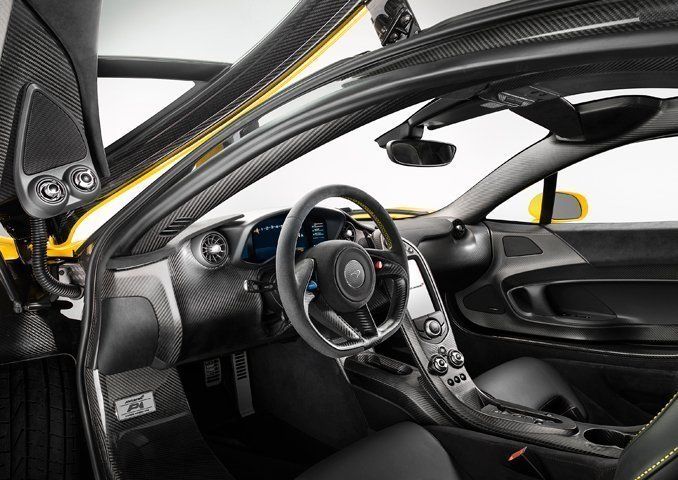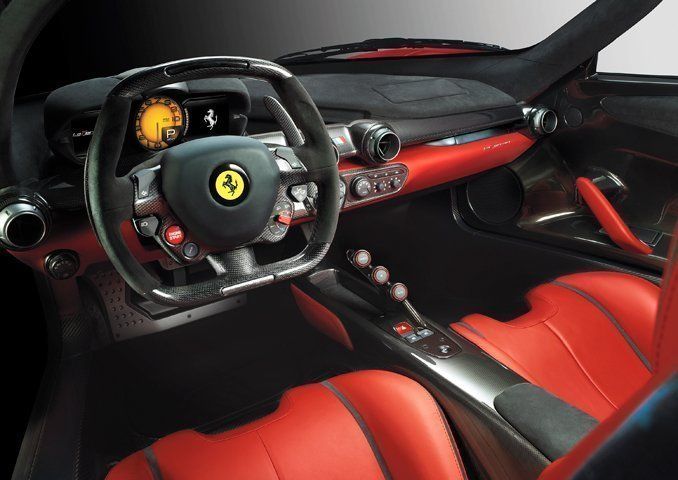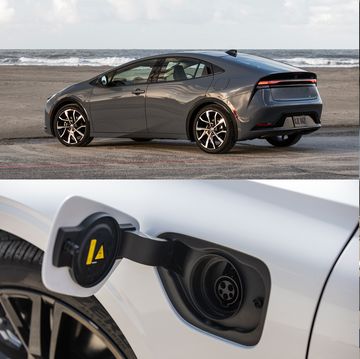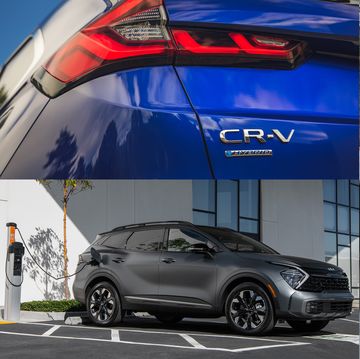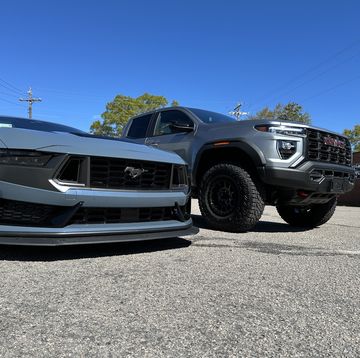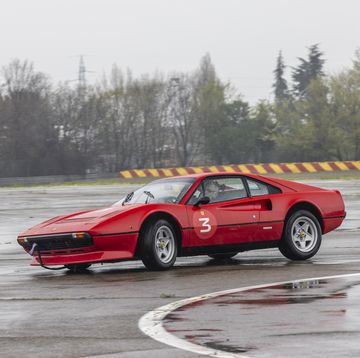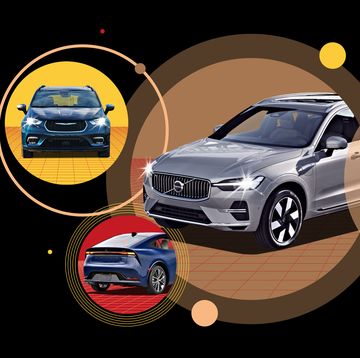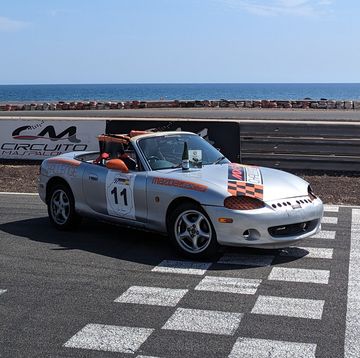From the June 2013 Issue of Car and Driver.
Geneva is a quiet Swiss city of enormous but restrained wealth. The Palexpo center, where the auto show is held every gray March, is modestly sized, and the automaker stands are, by regulation, relatively small. The scene is pretty chill.
If you wandered to the front of the Lamborghini sanctum this year, you saw a large pile of sharp knives called the Veneno. Prying your eyes off this gloriously absurd car-as-publicity-stunt was difficult, but walking another eight feet of industrial-grade red carpet brought you to the glossy-white altar of McLaren. There posed the production version of the 903-hp hybrid P1 hypercar, its smooth, melting-butter shape evoking the world’s most expensive personal massager. Its bright-yellow nose was pointedly aimed away from the Lamborghini.
Across the convention hall, Ferrari’s highly anticipated magnum opus of futuristic fastness, the 950-hp LaFerrari, drew a swarm of gawking, indoor-scarf-wearing European journalists like ants to a sugar cube.
Hypercars appear about as often as plagues of locusts, so to have three emerge together is quite remarkable. Just so we’re clear: We call these supercars or hypercars, but they are not, in any conventional sense, cars. They are idols, expressions of an ideal, advertising, fodder for bedroom-wall posters. So, for the purposes of this story, we will judge them that way, attempting to determine which totem’s visual message best aligns with its mission.
They appeared at Geneva because of the area’s wealth, its proximity to northern Italian design houses and exotic-car builders, and its tidy situation roughly halfway between two prime hypercar markets: The United States and the United Arab Emirates. No carmaker can claim Geneva as its home event, but Ferrari, Lamborghini, and McLaren were clearly vying for ownership rights this year. As Lamborghini’s Maurizio Reggiani told us: “It’s our motor show. We want to be king.”
Lamborghini Veneno
Highs: It will not be ignored, batteries are for the weak.
Lows: Poseur race car, unjustifiably angry, $3.9 million for a re-bodied Aventador?
Verdict: For those times when a lime-green Lamborghini is just too subtle.
Unlike the two other hypercars here, the Veneno is not a hybrid. And it’s not all-new, carrying mostly Aventador pieces under its cartoonish body. It stretches the concept of a “production car” further than even the P1, of which McLaren will build 375. The Veneno’s full run of just three examples (all are sold) makes the 499-count Ferrari LaFerrari seem Corolla-commonplace. At $3.9 million, the Veneno’s price is nearly three times that of both the LaFerrari and the P1 and ten times the tag of an Aventador.
The Veneno strives to look like a cross between a GT car and a Le Mans prototype, although it is neither. In the fashion of current prototype racers, its dorsal fin grows out of a rooftop snorkel and slices back to form a center strut for the insanely huge adjustable rear wing. The tall, narrow headlights look like spare parts from the Audi R18 Le Mans winner, and its entire rear end appears to be one enormous aerodynamic diffuser. Ironically, for all the Veneno’s elaborate race-grid getup, Lamborghini has the thinnest racing résumé of the hypercar makers here.
Its track-ready affectation might not be to our taste, but after all these years, Lamborghini still has a profound capability to stun even the most phlegmatic passers-by. Also, the 740-hp Veneno should be astoundingly quick and fast. Alone among these three, it has four-wheel drive, which will help offset some of its power deficit, at least on launch. Under the carbon-fiber skin lurks more Aventador hardware, including the four-wheel-drive system, the carbon-fiber tub with aluminum front and rear substructures, the single-clutch paddle-shift transmission, and the pushrod-activated suspension, albeit with its own tune.
The 6.5-liter V-12 gains 49 horsepower thanks to a larger intake, hotter cams, and a freer-flowing exhaust. We estimate it could bolt to 60 mph in 2.7 seconds, a few tenths quicker than the Aventador, and maintain that margin through the quarter-mile, doing the deed in 10.6 seconds on its way to about 221 mph. Not that we’re likely to ever confirm those numbers with a test.
But who knows? We didn’t anticipate Lamborghini would ever go into the business of selling all-but-one-off concept cars, either.
SPECIFICATIONS:
Vehicle type: mid-engine, 4-wheel-drive, 2-passenger, 2-door coupe
Base price: $3,910,379
Engine type: DOHC 48-valve V-12, aluminum block and heads, port fuel injection
Displacement: 397 cu in, 6498 cc
Power: 740 hp @ 8400 rpm
Torque: 509 lb-ft @ 5500 rpm
Transmission: 7-speed automated manualDimensions:
Wheelbase: 106.3 in
Length: 197.6 in
Width: 81.7 in
Height: 46.1 in
Curb weight: 3800 lb
Performance (C/D est):
Zero to 60 mph: 2.7 sec
Zero to 100 mph: 6.1 sec
1/4-mile: 10.6 sec
Top speed: 221 mph
McLaren P1
Highs: Trick suspension, video-arcade-game buttons.
Lows: It's not a conventionally pretty thing, is it? The old McLaren F1 was pretty.
Verdict: A race-car designer's approach to speed.
The McLaren P1 has a trick suspension that slams the car to just over two inches off the pavement in “race” mode to drop the center of gravity and increase downforce. The brake rotors trigger more than 2.0 g’s of maximum deceleration. Though spectacular, those feats are not the P1’s neatest tricks.
The greatest thing about the P1 is that McLaren has finally made a car for a generation of video-arcade Sennas. A button on the steering wheel’s right spoke is labeled IPAS (Instant Power Assist System). Anyone who spent his or her formative years behind the wheel of a quarter-eating video game knows it should be called the “Turbo Boost” or “Nitro” button. Press it and the lithium-ion battery pack discharges into the 177-hp electric motor mounted to the engine’s left flank, and then—boom—you either arrive at the horizon or crash into the back of something much slower than the P1.
Besides the IPAS button, the P1 offers an array of settings including normal, sport, track, and race. There is also a launch mode and even an e-mode for electric-only operation for up to six or so miles. This, says chief design engineer Dan Parry-Williams, makes the P1 eligible to enter zero-emission zones in some city centers, notably London.
Want more buttons? The steering wheel’s left spoke has one labeled DRS (Drag Reduction System). It trims the huge articulating rear wing to a flatter angle of attack, reducing drag by 23 percent, McLaren reckons. On the street, the wing rises nearly five inches proud of the body; while in “race” mode, it hovers nearly a foot above. Two flaps under the nose also automatically rotate to positions between zero and 60 degrees. Downforce peaks at 1323 pounds at 161 mph. Beyond that, the aero system starts bleeding off downforce up to the 217-mph governed top speed.
McLaren honcho Ron Dennis proclaimed in Geneva that the P1 would be “the fastest car in the world [on a racetrack].” Indeed, Parry-Williams says, “We just lost interest in top speed,” instead prioritizing acceleration and handling.
McLaren worked with Pirelli on specific P Zero Corsa tires able to handle the intense downforce and a claimed 2.0-plus-g of lateral grip. Parry-Williams says he hasn’t tried a set of the super-stiff Pirellis (245/35R-19 front, 315/30R-20 rear) on any other car, but expects it would be an unpleasant experience. “If we didn’t have the suspension, we wouldn’t be able to do the tire,” he adds. He’s referring to the RaceActive Chassis Control, which, like the current 12C, uses hydro-pneumatic suspension elements to make the P1 unusually comfy. This system has relatively soft coil springs but no anti-roll bars. Instead, hydraulic cylinders resembling conventional shocks handle damping duties, but they are plumbed to central nitrogen-pressurized accumulators that counteract roll.
The hybrid powertrain starts with the familiar mid-mounted 3.8-liter V-8 engine from the 12C, here producing 727 horsepower at 7500 rpm and 531 lb-ft of torque at 4000 rpm. The 134-hp bump comes largely from the additional 3 psi of boost produced by bigger turbochargers. The electric motor fills in the bottom end of the power curve, so there’s little worry about the additional spool-up time required by the upgraded turbos. Because McLaren wanted the brake pedal to feel linear and natural, there is no regeneration.
Numbers? Zero to 60 mph in about 2.6 seconds. That’s no small achievement for a car that must channel its 900-plus horsepower through only two tires. The quarter-mile should take a scant 9.9 seconds.
The P1 looks like what it is: a highly sophisticated exercise in aerodynamics and speed, with some painted panels pasted to it. It is pretty, but only in the nerdiest possible way.
SPECIFICATIONS:
Vehicle type: mid-engine, rear-wheel-drive, 2-passenger, 2-door coupe
Base price: $1,300,000
Engine type: twin-turbocharged and intercooled DOHC 32-valve 3.8-liter V-8, 727 hp, 531 lb-ft; AC electric motor, 177 hp; combined system, 903 hp
Transmission: 7-speed dual-clutch automatic with manual shifting mode
Dimensions:
Wheelbase: 105.1 in
Length: 180.6 in
Width: 76.6 in
Height: 46.8 in
Curb weight: 3300 lb
Performance (C/D est):
Zero to 60 mph: 2.6 sec
Zero to 100 mph: 5.2 sec
1/4-mile: 9.9 sec
Top speed: 217 mph
Ferrari LaFerrari
Highs: Batteries, yes, but also a 789-hp V-12.
Lows: Why not just call it the F70?
Verdict: What could be better than a modern-day Ferrari 330 P4?
The name of Maranello’s newest small-batch hypercar was a boon for wisecracking journalists. It is a terrible moniker, calling to mind the stage name of a stripper. But the LaFerrari was the darling of this show, drawing more attention than both the entire Volkswagen stand and the whole of Geneva’s red-light district (we’re guessing).
Ferrari’s approach to this, its fifth special-series hypercar—following the 288 GTO, F40, F50, and Enzo—is remarkably like that of its full-time Formula 1 nemesis, McLaren. Both have produced carbon-fiber capsules that power their rear wheels with a mid-mounted, electric-motor-boosted engine turning a seven-speed dual-clutch gearbox. Both make extensive use of technologies banned in F1, such as adaptive aerodynamic aids. Naturally, both employ the crazy-hinged doors that are a hallmark of this breed.
Working in Ferrari’s favor is its 789-hp 6.3-liter V-12, capable of spinning to 9250 rpm. As with McLaren, Ferrari uses its electric motor to fill the low-rpm power needs. The motor’s torque allows the company to let the V-12 rev to the stratosphere but still supply solid thrust at milder rpm, where it spends most of its time. The world’s most powerful road-going V-12 has a 13.5:1 compression ratio, a power peak at 9000 rpm, and variable-length intake ducts that rise and fall within the carbon-fiber intake plenum. The electric motor at the rear of the transaxle supplies an additional 161 horsepower. It feeds on electrons from 120 high-voltage battery cells in two liquid-cooled boxes in front of the engine. Combined horsepower is a not-insubstantial 950. That’s only 51 less than the Bugatti Veyron 16.4, but the Ferrari is about 1100 fewer pounds of car. That should be entertaining.
Beyond the V-12, the LaFerrari’s bewitching shape is its greatest strength. It represents a departure from the Enzo, which still stands as a disruptive, shocking, and divisive design. The LaFerrari doesn’t tote a big strut-mounted wing on its lovely rear. Instead, a ducktail spoiler moves in concert with two motorized flaps tucked between fins of the rear diffuser to adjust rear downforce. The flaps and spoiler tip down for low drag, up to create downforce. Other flaps ahead of the front wheels rise to increase downforce and balance the rear. Further, a front-center flap diverts under-nose air.
The aero package might be elaborate, but the interior is race-car spare. Ferrari doesn’t even put seats in the car. To save weight, occupants instead plant their butts on the carbon-fiber floor, albeit one shaped essentially like seats, custom padded for each customer at the factory, the same way a Formula 1 car is fitted to its driver. The pedal box and nearly square steering wheel are adjustable. Seat-back-angle adjustments: Zero. Hope you like it.
Buyers will pay something on the order of $1.35 million for the honor of taking home a LaFerrari. But hang on there, Mr. Powerball winner; Ferrari CEO Amedeo Felisa describes the LaFerrari as a “reward for the very loyal customer.” He indicates that to get in line, buyers will want to own more than five other Ferraris. That might not be the worst way to describe these things. Rewards for the faithful.
SPECIFICATIONS:
Vehicle type: mid-engine, rear-wheel-drive, 2-passenger, 2-door coupe
Estimated base price: $1,350,000
Engine type: DOHC 48-valve 6.3-liter V-12, 789 hp, 516 lb-ft; AC electric motor, 161 hp; combined system, 950 hp
Transmission: 7-speed dual-clutch automatic with manual shifting mode
Dimensions:
Wheelbase: 104.3 in
Length: 185.1 in
Width: 78.4 in
Height: 43.9 in
Curb weight: 3200 lb
Performance (C/D est):
Zero to 60 mph: 2.6 sec
Zero to 100 mph: 5.1 sec
1/4-mile: 9.8 sec
Top speed: 218 mph
Daniel Pund was named Road & Track's editor-in-chief in 2024 after helping to re-invent the venerable magazine brand as executive editor. For around 30 years, Pund has toiled away as a feature writer, car reviewer, editor, and columnist for every car magazine that matters (including Car and Driver and Autoweek) and a few that didn’t. He’s also contributed to Esquire and GQ and other general-interest publications.

